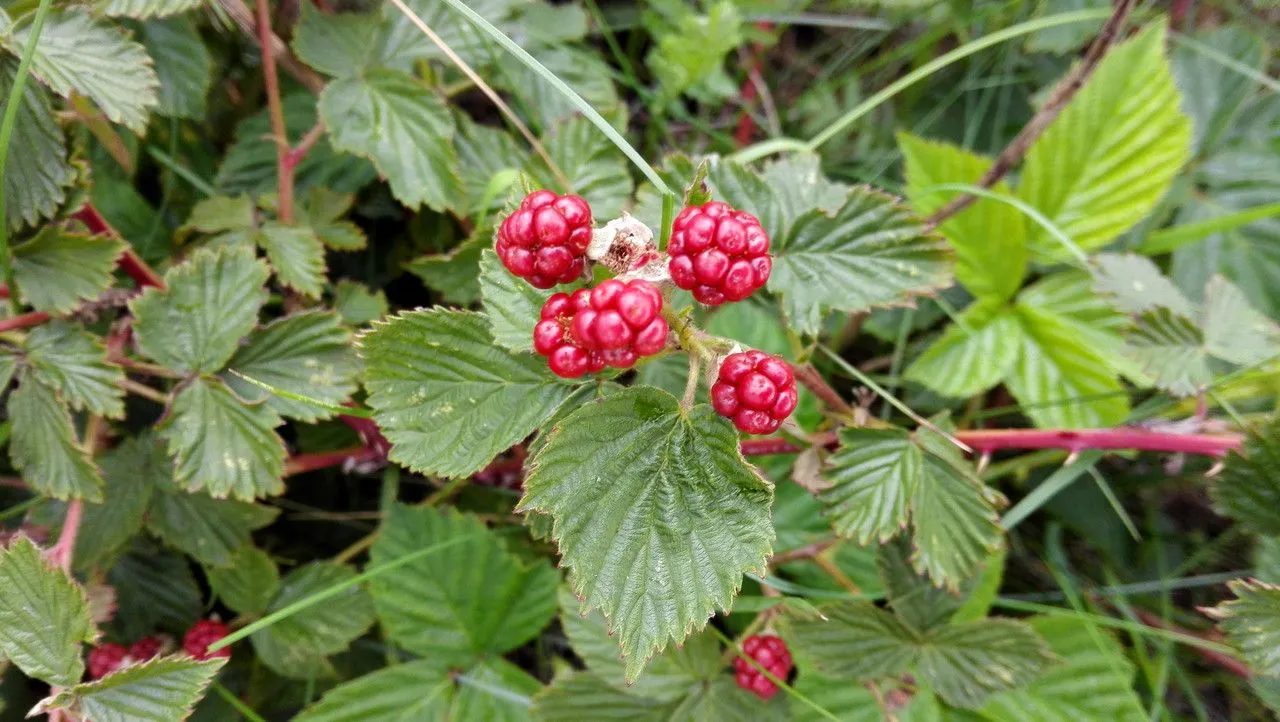
Author: P.J.Müll.
Bibliography: Flora 41: 130 (1858)
Year: 1858
Status: accepted
Rank: species
Genus: Rubus
Vegetable: False
Observations: Azores, N. & W. Europe
The Red-stemmed bramble, scientifically known as Rubus divaricatus, is a member of the Rosaceae family, a diverse group that includes many familiar fruit-bearing and ornamental plants. First documented in the scholarly flora publication “Flora” in 1858 by P.J. Müll., it is a plant species native to the regions of the Azores as well as northern and western parts of Europe.
This particular bramble stands out due to its distinctive red stems, which add a splash of color to the otherwise green and leafy environment it inhabits. Typically found in various habitats ranging from forest floors to open meadows and hedgerows, Rubus divaricatus thrives in temperate climates and can often be seen in the wild where it forms dense thickets.
The plant’s adaptability to different environments within Europe has allowed it to proliferate widely. Its growth pattern not only provides ground cover but also serves as an important food source for various fauna. The red-stemmed bramble produces clusters of white to pale pink flowers, which serve as rich nectar sources for pollinators such as bees and butterflies during the blooming season. Following pollination, the plant yields small, aggregate fruits that are not just consumed by wildlife but also have historical significance in local foraging traditions.
In landscaping and wild gardening, Rubus divaricatus is appreciated for its hardiness and its ability to quickly create impenetrable natural barriers. However, due to its vigorous growth, it can sometimes become invasive if not properly managed.
In summary, the Red-stemmed bramble, Rubus divaricatus, is a resilient and ecologically significant member of the Rosaceae family, with a presence that enhances the biodiversity of its native regions across the Azores and northern and western Europe. Its historical documentation can be traced back to 1858, reflecting the long-standing recognition of its role in both natural and cultivated landscapes.
Dan: glinsende brombær
Eng: red-stemmed bramble
Deu: sparrige brombeere
Swe: glansbjörnbär
Nld: bokkoepelbraam
En: Red-stemmed Bramble
Da: Glinsende brombær
Nl: Bokkoepelbraam
Fr: Ronce divariquée
De: Sparrige Brombeere
Sv: Glansbjörnbär
Taken Sep 8, 2020 by Sabina Hartmann (cc-by-sa)
Taken Aug 29, 2020 by Sabina Hartmann (cc-by-sa)
Taken Jul 16, 2020 by Sabina Hartmann (cc-by-sa)
Taken Aug 21, 2022 by Bella Nanni (cc-by-sa)
Taken Aug 29, 2020 by Sabina Hartmann (cc-by-sa)
Taken Jul 16, 2020 by Sabina Hartmann (cc-by-sa)
Taken Jul 16, 2020 by Sabina Hartmann (cc-by-sa)
Taken Sep 9, 2022 by Zoë Hampson (cc-by-sa)
Taken Aug 21, 2022 by Bella Nanni (cc-by-sa)
Taken Aug 21, 2022 by Bella Nanni (cc-by-sa)
Taken Aug 28, 2022 by Olivier Thomas (cc-by-sa)
Taken Aug 29, 2020 by Sabina Hartmann (cc-by-sa)
Taken Jul 16, 2020 by Sabina Hartmann (cc-by-sa)
Taken Sep 8, 2020 by Sabina Hartmann (cc-by-sa)
Taken Aug 29, 2020 by Sabina Hartmann (cc-by-sa)
Taken Jan 1, 1970 by Photoflora – L’Abbé COSTE (©)
© copyright of the Board of Trustees of the Royal Botanic Gardens, Kew.
© copyright of the Board of Trustees of the Royal Botanic Gardens, Kew.
© copyright of the Board of Trustees of the Royal Botanic Gardens, Kew.
Ph maximum: 5.0
Ph minimum: 4.5
Light: 6
Atmospheric humidity: 6
Bloom months: [‘jun’, ‘jul’]
Soil nutriments: 4
Family: Myrtaceae Author: (F.Muell.) K.D.Hill & L.A.S.Johnson Bibliography: Telopea 6: 402 (1995) Year: 1995 Status:…
Family: Rubiaceae Author: Pierre ex A.Froehner Bibliography: Notizbl. Bot. Gart. Berlin-Dahlem 1: 237 (1897) Year:…
Family: Sapindaceae Author: Koidz. Bibliography: J. Coll. Sci. Imp. Univ. Tokyo 32(1): 38 (1911) Year:…
Family: Asteraceae Author: A.Gray Bibliography: Pacif. Railr. Rep.: 107 (1857) Year: 1857 Status: accepted Rank:…
Family: Fabaceae Author: Medik. Bibliography: Vorles. Churpfälz. Phys.-Ökon. Ges. 2: 398 (1787) Year: 1787 Status:…
Family: Aspleniaceae Author: (Cav.) Alston Bibliography: Bull. Misc. Inform. Kew 1932: 309 (1932) Year: 1932…